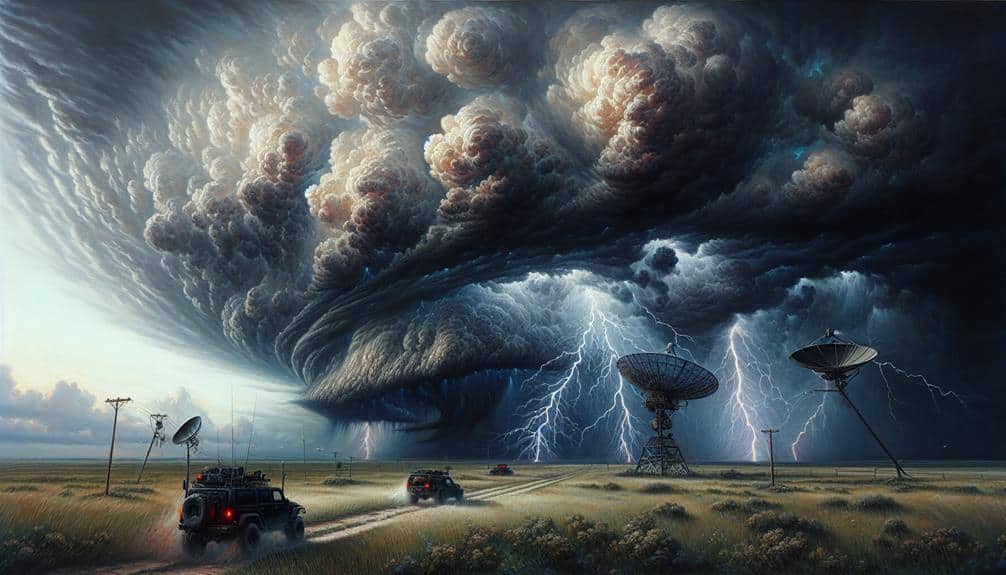We intercept severe thunderstorms because the convergence of atmospheric instability, wind shear, and moisture offers an unparalleled adrenaline rush while yielding vital meteorological data. With our radar, GPS systems, and barometers, we can safely position around the storm's intensity. The risk of lightning strikes or tornadoes is real, but the scientific rewards are immense. Our careful analysis, using satellite and weather models, supports quick, informed decisions. The thrill of nature's power, the pursuit of extreme weather, and the meticulous planning make it all worthwhile. There's even more to understand about our motivations and the science behind storm chasing.
Key Points
- Adrenaline seekers are driven by the thrill of witnessing nature's powerful phenomena up close.
- The pursuit provides an adrenaline rush and a sense of freedom and exhilaration.
- Collecting valuable meteorological data during storms offers scientific rewards and personal satisfaction.
- Collaborative storm chasing within a community fosters shared knowledge and mutual support.
The Thrill of the Chase
Chasing severe thunderstorms offers an adrenaline rush driven by the convergence of meteorological phenomena and the pursuit of capturing rare atmospheric events. When we venture on these storm-chasing adventures, we're acutely aware of the risk versus reward calculus that defines the experience.
The reward is twofold: the sheer thrill of being in the presence of nature's raw power and the opportunity to gather invaluable data. The adrenaline rush we feel isn't just from the danger but also from the possibility of witnessing and documenting phenomena like mesoscale convective systems or supercell formations.
We rely on accurate data and real-time meteorological information to make informed decisions. High-resolution radar, satellite imagery, and storm tracking software become our lifelines. Despite the inherent risks—lightning strikes, hail, and tornadoes—the potential scientific and experiential rewards drive us forward.
The risk versus reward equation isn't static; it evolves with each storm's intensity and our ability to adapt and respond.
Our journeys aren't just about the chase but about the freedom to explore and understand the dynamic atmosphere. This balance of risk and reward keeps us coming back, seeking that perfect storm that combines beauty, danger, and scientific discovery.
Understanding Severe Storms
To truly understand the complexity of severe storms, we explore the intricate dynamics of atmospheric instability, wind shear, and moisture.
Severe thunderstorms form when these elements converge in precise ways. Atmospheric instability occurs when warm, moist air near the Earth's surface rises rapidly into cooler, drier air aloft. This creates the potential for strong updrafts, a key ingredient for thunderstorm development.
Wind shear, the change in wind speed or direction with height, plays an essential role in storm structure and longevity. It influences the rotation of storm cells, often leading to the formation of supercells, which are notorious for producing violent tornadoes.
We analyze weather patterns meticulously to predict these conditions, using data from satellites, radar, and weather models.
Storm chasing techniques involve real-time interpretation of these data to position ourselves in ideal viewing locations. By understanding the interplay between atmospheric instability, wind shear, and moisture, we can make educated decisions on where a storm is most likely to intensify.
This scientific approach not only fuels our passion for freedom and discovery but also contributes valuable insights into severe weather phenomena, potentially aiding in public safety and awareness.
Equipment and Safety Measures
Equipped with a deep understanding of severe storm dynamics, we must also prioritize the specialized gear and rigorous safety protocols necessary for storm chasing.
Our commitment to safety precautions and preparedness is non-negotiable, given the unpredictable and hazardous nature of severe thunderstorms.
To optimize our safety and maximize our data collection, we rely on a detailed set of storm chasing gear:
- Radar and GPS Systems: High-resolution radar is essential for tracking storm cells and identifying potential tornadoes. GPS systems help us navigate and position ourselves in ideal viewing locations without getting caught in the storm's path.
- Reinforced Vehicles: Our vehicles are modified with reinforced windows and body panels to withstand hail and debris. Additionally, they're equipped with weather instruments like anemometers and barometers to record real-time data.
- Communication Devices: Reliable communication is crucial. We use two-way radios and satellite phones to stay in touch with team members and emergency services, ensuring coordination and rapid response.
Adhering to these safety measures allows us to embrace the freedom and excitement of storm chasing while minimizing risk.
Psychological Aspects
Understanding the psychological aspects of storm chasing highlights the complex interplay between thrill-seeking behavior and risk assessment in extreme weather environments. Our pursuit of severe thunderstorms is driven by a unique combination of emotional responses and calculated decisions.
Thrill-seekers often exhibit a heightened need for excitement, which fuels their desire to engage in high-risk activities like storm chasing. Risk assessment is a critical factor in this endeavor. We constantly evaluate the potential dangers posed by severe weather while balancing our quest for adrenaline.
This assessment involves analyzing meteorological data, understanding storm dynamics, and anticipating potential hazards. The ability to make quick, informed decisions under pressure is paramount for both safety and success. Our emotional response to storm chasing plays a significant role in our motivation.
The exhilaration of witnessing nature's raw power can be addictive, providing a sense of freedom and empowerment. This intense emotional experience often outweighs the perceived risks, leading us to continually seek out severe weather events. In essence, the psychological aspects of storm chasing are characterized by a delicate balance between the thrill of the chase and the necessity of rigorous risk assessment, driven by powerful emotional responses to extreme weather phenomena.
Community and Culture

The storm chasing community fosters a unique culture built on shared knowledge, mutual support, and a collective passion for extreme weather phenomena. We've built a network that thrives on the adrenaline rush of intercepting severe thunderstorms, combining scientific rigor with the excitement of the chase.
Our culture is defined by a few core elements:
- Collaboration: We share real-time data, weather models, and storm reports to guarantee everyone's safety and success.
- Education: Through workshops and seminars, we enhance our understanding of meteorological patterns, storm structures, and safety protocols.
- Innovation: We constantly develop and test new technologies, from advanced radar systems to mobile weather stations.
In our community, storm chasing isn't just a hobby; it's a disciplined pursuit that requires meticulous planning and execution. The adrenaline rush we experience during a successful interception is unparalleled, but we also recognize the importance of respecting nature's power.
Data from our chases often contribute to broader meteorological studies, providing invaluable insights into storm behavior and helping improve predictive models.
Our collective ethos emphasizes freedom—the freedom to explore, to learn, and to push the boundaries of what's known about severe weather. Each chase is a new opportunity to discover and grow together.
Frequently Asked Questions
How Do Adrenaline Seekers Balance Storm Chasing With Their Personal and Professional Lives?
We balance storm chasing with our personal and professional lives by maintaining a work-life balance. We employ thrill-seeking strategies while adhering to strict safety precautions, ensuring the adrenaline rush doesn't compromise our responsibilities or well-being.
What Legal Permissions Are Required for Storm Chasing Activities?
We need to make sure we adhere to regulations, obtain necessary permits, and take safety precautions. Ethical considerations and proper insurance coverage are essential for responsible storm chasing, balancing freedom with safety and scientific accuracy.
Just as explorers map uncharted lands, we capture storm data through cutting-edge technology. We analyze this data and collaborate with scientists, using advanced communication tools to share our findings, pushing the boundaries of meteorological understanding.
What Impact Does Storm Chasing Have on Local Ecosystems and Wildlife?
We recognize storm chasing can cause ecological disturbances and alter wildlife behavior. However, our data-driven conservation efforts aim to mitigate storm impact, ensuring minimal long-term disruption and promoting sustainable practices to protect local ecosystems and wildlife.
How Do Storm Chasers Handle Mental Health Challenges Post-Chase?
We handle mental health challenges post-chase by employing coping strategies and robust support systems. Prioritizing mental health through self-care practices and peer support networks guarantees we maintain emotional resilience and psychological well-being after intense storm chasing experiences.


